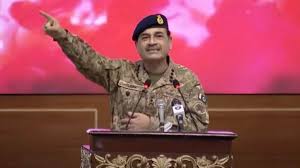ISLAMABAD: Pakistan Army Chief General Asim Munir’s leadership is pushing Pakistan toward internal collapse, according to an OpEd by Aleya Sheikh published in Eurasia Review.
With the civilian government sidelined, Pakistan’s military establishment under Munir’s command is accused of fuelling domestic instability, economic disaster, and dangerous confrontations with India in a desperate bid to retain control.
In Pakistan, as the economy collapses, armed insurgencies strengthen in Balochistan and Khyber Pakhtunkhwa (KP), and public resentment against the military grows fiercer, Pakistan now faces its gravest existential threat since the 1971 secession of Bangladesh.
To divert attention from Pakistan’s internal decay, Munir has adopted an increasingly reckless tactic: stoking tensions with India. The April 22, 2025, terror attack on tourists in Pahalgam, Kashmir, which killed 26 innocent civilians, was described as a deliberate act, orchestrated by Pakistan-backed terrorist groups under Rawalpindi’s supervision,says the OpEd.
This was not a rogue incident but one executed under Munir’s direct watch, aimed at sparking communal unrest and provoking Indian retaliation. Tensions escalated further when Pakistan conducted a surface-to-surface missile test from Karachi’s coast shortly after the attack, heightening regional fears, the author argues.
Amid a global scramble for economic partnerships with India’s growing market, Pakistan’s leadership has severed trade ties with its neighbour, further isolating the country economically. The decision, reportedly imposed by General Munir, stands in contrast to civilian leaders like the Sharif brothers who historically advocated for increased trade with India. Pakistan’s deepening economic crisis is exacerbated by this strategic miscalculation, shrinking potential economic lifelines at a time when they are desperately needed.
With diplomatic isolation mounting, Munir has resorted to exporting terrorism as a tool to engineer nationalism at home. However, this outdated strategy has drawn a clear warning from India’s leadership, which has vowed decisive retaliation for any attacks. In trying to manufacture unity through conflict, Munir is risking not just Pakistan’s internal stability but regional peace as well. His policies are increasingly seen as dismantling Pakistan from within, suppressing civilian freedoms, and driving the country toward violent collapse, the author says.
Balochistan today stands as a stark testament to the consequences of Munir’s rule. Rather than engaging in political dialogue or promoting development, the military has intensified its campaign of repression. Enforced disappearances, extrajudicial killings, and systematic human rights abuses are now daily realities for the Baloch people. According to the Human Rights Council of Balochistan (HRCB), February 2025 alone saw 144 cases of enforced disappearances and 46 killings.
The pattern of repression mirrors the tactics used during the 1971 genocide in East Pakistan, where mass atrocities led to the creation of Bangladesh. As in 1971, instead of addressing legitimate political grievances, Pakistan’s military has chosen brutal suppression, fueling an increasingly organised and widespread insurgency. Young Baloch, radicalised by state violence, now target military convoys, Chinese projects, and critical infrastructure, endangering the future of initiatives like the China-Pakistan Economic Corridor (CPEC).
Similarly, in Khyber Pakhtunkhwa, the state’s authority is visibly eroding. The Pashtun Tahafuz Movement (PTM), led by Manzoor Pashteen, began as a peaceful demand for civil rights but has faced relentless military crackdowns. This heavy-handed approach has alienated the Pashtun youth, historically among the army’s strongest supporters, and intensified calls for self-determination.
Public rallies, YouTube videos, and street protests have increasingly exposed accusations of army collusion with Tehrik-e-Taliban Pakistan (TTP) militants, while police forces in districts like Lakki-Marwat and Bannu accuse army units of undermining counterterrorism operations.
The KP Assembly’s resolution demanding court-martials of army officers for political interference further highlights the deepening civil-military rift.
Externally, Munir’s policies have also backfired spectacularly in Afghanistan. Once viewed as Pakistan’s strategic victory, the Taliban regime in Kabul has grown increasingly hostile under Munir’s leadership. Refusing to recognise the Durand Line and cutting trade ties, the Taliban now prioritise Afghan nationalist interests, undermining Pakistan’s influence.
Munir’s internal political manoeuvres have proven equally destructive. His crackdown on former Prime Minister Imran Khan and the Pakistan Tehreek-e-Insaf (PTI) party has shattered the illusion of civilian governance. Khan’s arrest and the subsequent military-led suppression triggered nationwide outrage, including unprecedented attacks on military installations such as the General Headquarters in Rawalpindi. The mass arrests of PTI supporters and coercion of political figures have deepened public anger against the military elite.
Despite years of using fear to control the populace, the Pakistani military now faces an increasingly fearless public. Discontent, once confined to marginalised regions, has spread to the Punjabi heartland, creating a broad-based resistance that threatens the military’s longstanding dominance, the author argues.
Economically, Pakistan’s situation continues to deteriorate. With inflation surging past 38.5 per cent, a dangerous 70 per cent debt-to-GDP ratio, and crucial exports like wheat, rice, and cotton imperilled by the suspension of Indus water flows following the Pahalgam attack, the country is edging closer to full-scale collapse. Despite securing temporary relief through a USD 1.3 billion IMF bailout and a USD 1 billion climate loan, Pakistan faces USD 22 billion in external debt repayments in FY2025, with no sustainable plan in sight.


